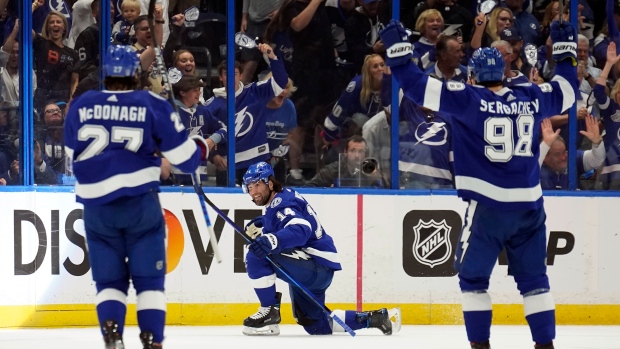May 9, 2022
The NHL’s scoring surge continues early in the postseason
The NHL is starting to accomplish a goal it has talked about for more than a decade: a sustained increase in scoring without overhauling the sport itself, Travis Yost writes.
By Travis Yost

For two seasons now, we have seen an acute rise in scoring rates across the National Hockey League. This year’s move to the upside was particularly aggressive, and playoff contenders differentiated themselves from the pretenders through their ability to score at high rates.
Save for perhaps the Dallas Stars and their defensive prowess, this is a postseason defined by great offensive teams facing great offensive teams. We’ve seen scoring grind to a halt in prior postseasons for a variety of reasons. Sometimes it’s the great goaltenders taking over games. Other times it seems like marked changes in officiating standards curb offence. And, sprinkled in over the past 15 years or so, a handful of elite defensive teams have managed to slow the pace of games and put the league’s most prolific scorers in a torture chamber. (This was just last season.)
But after the opening week of this year’s postseason, we are seeing more of the same – a lot more of the same. Even-strength scoring is at its most elevated in 15 years, and it’s not from a short-term surge in shooting percentages. Expected goals are also aggressively moving upwards, while the ratio of playoff scoring to regular season is close to par. (Note: power-play rate scoring is in line and, at least for now, not a driver of the scoring increase in the playoffs.)

The other notable takeaway from this? Look at the relationship between playoff scoring and regular-season scoring over the past four years. Stifling defensive play from the Montreal Canadiens last year saw them move into the Stanley Cup Final; the year prior, the Tampa Bay Lightning leaned heavily on their defence and goaltender Andrei Vasilevskiy to win their first Stanley Cup. And the year before that? The Boston Bruins, another great defensive team, silenced the rest of the Eastern Conference before losing in the Stanley Cup Final.
Those teams, to some degree, kept the narrative of “the playoffs are low-scoring and defence wins championships” alive and well. But this year, there seems to be a noticeable absence of that team. Rick Bowness’ Stars certainly fit the bill of a great defensive team that wins by choking games out, and they have frustrated the high-flying Calgary Flames in their opening three games. In the absence of Dallas making a run, though, this year’s winner is likely to score their way to the title.
Consider each first-round matchup. The below shows each team’s per game scoring rate over the course of the playoffs versus their regular season benchmarks.
Knowing how playoff scoring is generally down from regular-season scoring, seeing five of eight series above expectations feels extraordinary. Only one series – Dallas versus Calgary, of course – has seen a big drop in scoring so far:

If you subscribe to the belief that more offence means more entertainment, and that the NHL’s low-scoring baselines of the past decade ran counter to what the sport should look like, this development is a long time coming.
It’s important to frame why this surge in scoring now has some legitimacy:
- Regular-season scoring was up significantly and now part of a five-year uptrend
- The correlation between scoring ability and win-loss record continues to rise, indicating teams are differentiating themselves through an ability to score
- Teams are deploying deeper, more skilled lineups over time
- Playoff scoring is now also on the move north, unlike prior seasons
- The move in playoff scoring is not being aided by a change in officiating or a short-term fluctuation in conversion rates
We will see what happens over the course of the playoffs, but I think the NHL is starting to accomplish what it has talked about for more than a decade: a sustained increase in scoring without overhauling the sport itself. It didn’t take perpetually tweaking the size of goaltender equipment or any other immaterial rule changes.
This is about talent, an evolution in roster-building, core changes to structural strategy, and the overarching incentive systems. It’s taken time. And you can rest assured the defensive masterminds of the sport are working overtime right now.
That’s the ironic part in this. The league’s best teams are now the league’s best offensive teams. But the teams who win come May and June will still need to get it done on both ends of the ice. And to that end, defence can never fall out of favour long-term.
Data via Natural Stat Trick, NHL.com, Evolving Hockey

